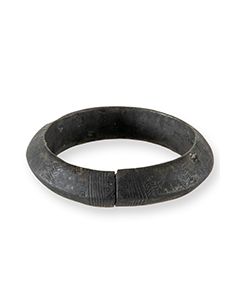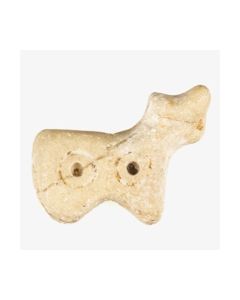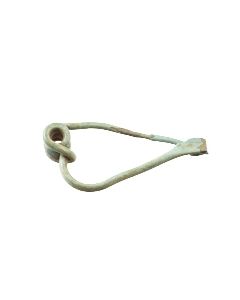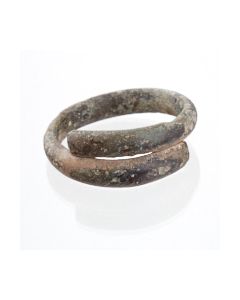Jewellery - Bronze Age - Recent acquisitions - Sold antiquities
Archive of sold antiquities
All artefacts sold in our gallery are fully documented in our online archive and database. Being a specialist ancient art dealer, preserving also the more recent history of each and every piece sold in our shop is at our heart. That is particularly useful for artefacts that changed owners in the meantime. Information that may have been lost in the process can be easily restored from our archives. Please do not hesitate to contact us if you need further information about ancient items that have been sold in our gallery. We can help you with reconstructing the history of ownership for those items. All information about our customers will be kept confidential, of course.-
 Group of Italic brooches and artefacts
Group of Italic brooches and artefactsExciting group of 17 bronze objects. These include an Italian serpentine fibula with large disc head, three early Etruscan brooches, and a bronze sheet with a decorative head.
Price: on request Bronze Age bracelet with incised decoration
Bronze Age bracelet with incised decorationThe jewellery was made in Europe during the 2nd millennium BC. Nice, dark patina.
Price: on request Bronze Age bracelet with incised decoration
Bronze Age bracelet with incised decorationThe jewellery was made in Europe during the 2nd millennium BC. Nice, dark patina.
Price: on request Egyptian hippopotamus amulet
Egyptian hippopotamus amuletMade in the style of a scarab but with a hippopotamus on the upper side. It was a protective amulet during the 18th or 19th dynasty of Ancient Egypt. It might have protected a pregnant woman. The amulet comes from the famous Matouk collection and is published in his 1971 book.
Price: on request Syrian amulet in animal shape
Syrian amulet in animal shapeSmall amulet of nice red stone in the stylized shape of a pig. From the 3rd Millenium BC.
Price: on request Sumerian miniature ram amulet
Sumerian miniature ram amuletNice small stone amulet in the stylized shape of a ram. From the 3rd Millenium BC.
Price: on request Sumerian ram amulet
Sumerian ram amuletNice small stone amulet in the stylized shape of a ram. From the 3rd Millenium BC.
Price: on request Sumerian miniature ram amulet
Sumerian miniature ram amuletNice small stone amulet in the stylized shape of a ram. From the 3rd Millenium BC.
Price: on request Large decorated violin bow fibula
Large decorated violin bow fibulaImpressive piece of jewellery because of its size and decoration. From Central Europe, made during Late Bronze Age or Early Iron Age.
Price: on request Bow fibula of the Urnfield culture
Bow fibula of the Urnfield cultureExcessively rare brooch type from Late Bronze Age in Bavaria. It is known from the Urnfield period hoard of Reisen near Munich in Germany. This piece has been found near Regensburg, Germany.
Price: on request Socketed axe head from Southern Germany
Socketed axe head from Southern GermanyA typical bronze tool of the late Urnfield culture or early Hallstatt culture. It was found near Regensburg in Southern Germany by a voluntary archaeologist.
Price: on request Egyptian Eye of Horus, New Kingdom
Egyptian Eye of Horus, New KingdomSmall amulet in form of the Eye of Horus. Popular type of protective amulet from Ancient Egypt.
Price: on request Egyptian Eye of Horus
Egyptian Eye of HorusSmall amulet in form of the Eye of Horus. Popular type of protective amulet from Ancient Egypt.
Price: on request Early bow brooch of the Urnfield period
Early bow brooch of the Urnfield periodSimple fibula shape dating to the Late Bronze Age. Interesting mix of two-sided spiral spring and simple pin holder.
Price: on request Egyptian fingerring from the Amarna period
Egyptian fingerring from the Amarna periodMade of colourful turquoise fayence. Two fully modelled crocodiles adorn the plate. Perfect preservation including original black paint.
Price: on request Egyptian faience ring showing Bes and Taweret
Egyptian faience ring showing Bes and TaweretThe finger ring with its scene on the plate must have served a protective function for an expectant mother. New Kingdom, approx. 1550 to 1070 BC.
Price: on request
 Double spiral pendant from Bronze Age Central Europe
Double spiral pendant from Bronze Age Central EuropeTypical decorative element of a wealthy woman's dress in the European Middle Bronze Age. Several of these spiral pendants were worn around the waist. Similar to belt mounts or charms. 1500 to 1200 BC.
Price: on request Ägyptischer Skarabäus mit Knotenmuster
Ägyptischer Skarabäus mit Knotenmuster12. bis 18. Dynastie des Alten Ägypten, ca. 2000 v. Chr. bis 1300 v. Chr. Die Stempelfläche trägt ein Knotenmuster mit ästhetischer oder mutmaßlich magischer Funktion.
Price: on request Ring aus der Bronzezeit
Ring aus der BronzezeitEleganter Schmuckring mit überlappenden Enden. Türkisfarbene Bronzepatina.
Price: on request Schmuckring aus der Bronzezeit
Schmuckring aus der BronzezeitMassiver Schmuckring mit überlappenden Enden. Dunkle Patina.
Price: on request Schmuckring aus Bronze
Schmuckring aus BronzeKreisförmiger Ring mit Überlapp. Die Oberfläche ist dezent mit einem Rillendekor verziert. Schön erhaltenes Exemplar mit lebhafter Patina.
Price: on request Ägyptisches Skarabäusamulett
Ägyptisches SkarabäusamulettSkarabäussiegel aus dem 2. Jt. v. Chr. mit ansprechender türkisfarbener Fayenceoberfläche. Die Stempelfläche trägt eine hieroglyphische Inschrift.
Price: on request Skaraboides Stempelsiegel
Skaraboides StempelsiegelÄgyptisches Stempelsiegel-Amulett in der stark stilisierten Form eines Skarabäuskäfers. Die Stempelfläche trägt eine symbolische Verzierung. 1. Jt. v. Chr.
Price: on request Skarabäusamulett aus der Hyksoszeit
Skarabäusamulett aus der HyksoszeitÄgyptisches Skarabäusamulett mit typischen Symbolen für die Herrschaftszeit der Hyksos. Aus der Zeit der Fremdherrschaft, ca. 1650 bis 1550 v. Chr.
Price: on request Ägyptisches Skarabäusamulett aus der 18. Dynastie
Ägyptisches Skarabäusamulett aus der 18. DynastieÄgyptisches Stempelsiegel-Amulett in der stilisierten Form eines Skarabäuskäfers. Die Stempelfläche trägt Hieroglyphen. Das Amulett datiert in die 18. Dynastie des Alten Ägyptens.
Price: on request Skarabäussiegel mit abstaktem Stempelmotiv
Skarabäussiegel mit abstaktem StempelmotivDie Stempelfläche trägt ein dekoratives Muster mit ästhetischer oder magischer Funktion. Sehr schöner und anschaulicher Skarabäus, in etwa aus der Zweiten Zwischenzeit des Alten Ägyptens. 2000 bis 1300 v. Chr.
Price: on request Großes Skarabäussiegel aus der Zeit des Amenophis III.
Großes Skarabäussiegel aus der Zeit des Amenophis III.14. Jh. v. Chr. Heute noch erhaltene Überreste der Bautätigkeit Amenophis III. sind die Memnonkolosse, sowie der Hauptteil des Luxor-Tempels.
Price: on request Ancient bronze bracelet with impressive patina
Ancient bronze bracelet with impressive patinaOvaler Armreif mit Überlapp. Die Enden sind in charakteristischer Weise verdickt und bilden einen klaren Abschluss. Attraktive polychrome Patina.
Price: on request

